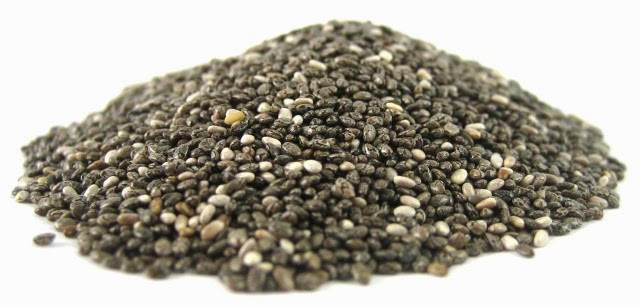What is chia?
The seeds come from Salvia Hispanica plant, which is native to southern Mexico and Guatemala although they are cultivated in many other places now especially in Australia, which is probably the worlds largest producer. The seeds can be black, brown or white and the nutritional value is more or less the same, although the darker seeds have a slightly higher concentration of antioxidants.
Chia seeds are often compared to flax seeds because they have similar nutritional profiles. But the main difference is that chia seeds don't need to be ground the way flax seeds do. Chia also has a longer shelf life and does not go rancid like flax does.
Nutrition facts and benefits
Essential minerals for your bones and teeth
A serving of chia seeds - that's around 15g or a level tablespoon - has 18% of the recommended daily intake for calcium, which puts your well on your way to maintaining bone and oral health, and preventing osteoporosis. Chia seeds give you 27% of your daily value for phosphorus, a mineral that also helps you maintain healthy bones and teeth. Phosphorus is also used by the body to synthesize protein for cell and tissue growth and repair.
Manganese isn't a well-known nutrient, but it's important for our health: it's good for your bones and helps your body use other essential nutrients like biotin and thiamin. One serving of chia seeds, or 28 grams, has 30% of your recommended intake of this mineral.
More anti-oxidants than in blueberries
The antioxidant content (which includes quercetin, caffeic acid and chloregenic acid) in chia seeds has an impressively high ranking on the ORAC scale (oxygen radical absorbance capacity) at over 10,000 per 100g (blueberries have 9,000).
Complete protein
Chia seeds are a complete protein as they have all the essential amino acids and so are useful for vegetarians and vegans. Moreover, chia seeds don't have any cholesterol. One 28-gram serving of these super seeds has 4.4 grams of protein, nearly 10% of the daily value.
Rich in fibre, chia is a natural aid in controlling DIABETES
Chia seeds have a very good amount of fibre: just a 28-gram or one-ounce serving of chia has 11 grams of dietary fibre — about a third of the recommended daily intake for adults.
But here's where it gets really cool. If you soak chia seeds in water for about 30 minutes, you will get a glass of almost solid gelatin. Science believes this is the result of the soluble fiber in the chia. These fibers, known as mucilages, may also form this gel-like texture in the stomach when you eat chia, creating a barrier between carbohydrates and the digestive enzymes that break them down, slowing the conversion of carbohydrates to sugar... so they can be a natural aid in controlling diabetes!
Chia seeds are the "perfect food" for WEIGHT LOSS
And chia can help you get skinny. Because they can help prevent the absorption of some of the food you eat (along with the calories), chia can be a great asset to any diet plan. And with their high fiber content and nutritional density, chia helps dieters feel fuller faster and remain sated for longer periods of time. Tryptophan, an amino acid found in turkey, is also found in chia seeds. Tryptophan helps regulate appetite, sleep and improve mood.
Chia seeds: great enhancer in hydrating our bodies, a valuable tool for athletes
It gets better. Chia seeds are considered to be hydrophilic, meaning they can absorb large amounts of water quickly. They can hold 10 times their weight in water, making them a great enhancer in hydrating our bodies, a valuable tool for athletes or anyone looking to improve their day to day performance and endurance.
Rich in Omega-3, chia lowers risk of heart disease
But it's the fat content of chia that seems to be a focal point for its supporters. Eaten raw, chia seeds contain a rich concentration of essential fatty acids, with 30% of their fat coming from omega-3 and 10% from omega-6, considered the perfect balance for healthy human tissue.
According to the Cleveland Clinic, chia seeds have been shown to improve blood pressure in diabetics, and may also increase healthy cholesterol while lowering total, LDL, and triglyceride cholesterol.
How to use chia seeds
With no cholesterol, simple sugar or gluten, high in the most prized nutrients we need, easy to digest and needing no grinding, chia seeds could well be nature's perfect food. At 137 calories an ounce, they just may be one of the healthiest things around...
You can simply sprinkle them on various dishes, like salads and whole grains; you can soak and sprout them to create smoothies or morning porridges, like oatmeal; you can add them to baked goods like breads, muffins and biscuits. Small, like poppy seeds, chia are mildly nutty, but without a strong flavor, so they can be used in a variety of ways without altering the flavor of a dish.
Here are two easy to make recipes...
Roasted chia cauliflower
Sources: http://healthyeating.sfgate.com/, http://www.huffingtonpost.ca/, http://www.huffingtonpost.com/, http://ohmyveggies.com/recipe-roasted-chia-cauliflower/, http://ohmyveggies.com/how-to-make-your-own-chia-drink-pomegranate-lime-chia-fresca-recipe/









